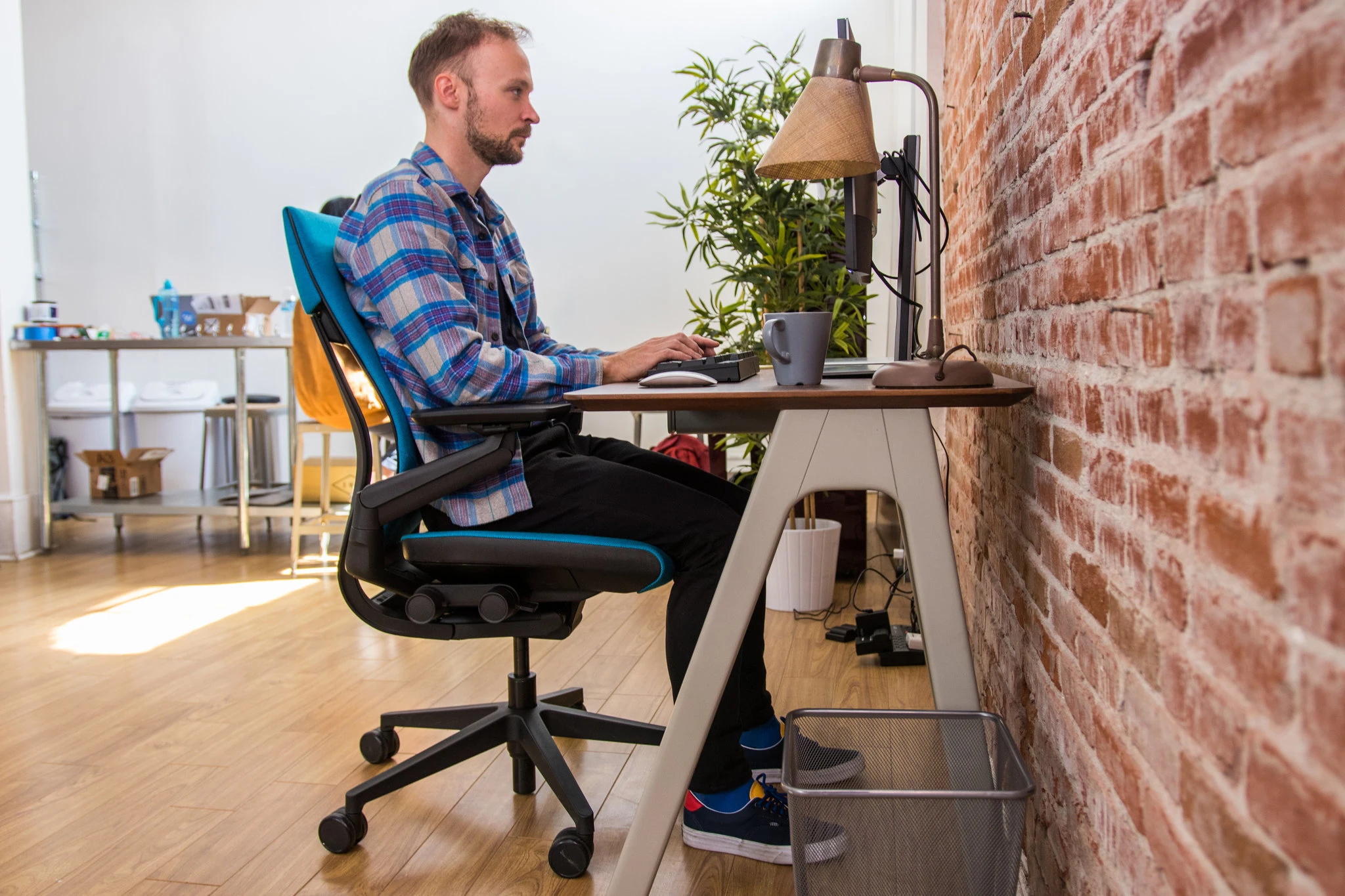In today’s digital age, where desk jobs dominate, the significance of a well-designed office chair is paramount. More than just a comfort provider, your office chair can significantly influence your long-term health, particularly in preventing chronic hip pain.
Experiencing hip pain can be a crippling ordeal, impacting your productivity, comfort, and overall quality of life. However, an office chair, engineered with ergonomic principles, can be a game-changer.
In this comprehensive guide, we’ll navigate the realm of ergonomic seating, empowering you to select an office chair that offers unparalleled support and aids in mitigating hip pain.
Unraveling the Causes of Hip Pain
Hip pain is a prevalent issue affecting individuals across all age groups and lifestyles. While its roots can be multifaceted, a significant contributor to this discomfort is the prolonged sitting often associated with office environments. To effectively combat hip pain, understanding its underlying causes is essential.

Hip pain can stem from various sources, including:
- Prolonged Sitting with Poor Posture: Extended periods of sitting with improper posture, such as slouching or crossing legs, can put strain on the hip joints and surrounding muscles.
- Sedentary Lifestyle: Remaining inactive for extended hours can lead to decreased blood flow to the hip region, resulting in discomfort and stiffness.
- Inadequate Chair Design: Chairs lacking proper lumbar support, seat depth adjustments, or cushioning can contribute to hip pain over time.
- Muscle Imbalances: Weak or overly tight hip muscles can create imbalances, eventually leading to hip pain.
- Repetitive Movements: Occupations or activities that require repetitive hip movements can place undue stress on the hip joints, causing discomfort.
Hip pain can manifest in various ways, including dull, persistent pain in the hip joint or groin, sharp pain during specific movements, stiffness, reduced range of motion, and discomfort that intensifies with prolonged sitting or physical activity, interfering with daily activities.
To effectively combat hip discomfort, it’s not just about immediate relief but also about ensuring long-term hip health. An ergonomic office chair, precisely designed to support the hip region, can be a pivotal element in preventing and soothing discomfort, facilitating extended periods of comfortable sitting and working.
The Role of Ergonomics in Alleviating Hip Discomfort
Ergonomics is not just a buzzword in the world of office furniture. It’s a science that focuses on designing products and environments that fit the human body’s natural form and movements. When it comes to office chairs and hip health, ergonomics plays a pivotal role.
Optimal Hip Support
Ergonomic office chairs, like the Ergonomic Chair, are designed to provide optimal support to the hips. They feature contoured seats that allow your legs to get the support they need all the way down the thighs, allowing your hips to rest comfortably and maintain their natural alignment. This reduces pressure on the hip joints and muscles.
Adjustability for Personalization
Ergonomic chairs come with a range of adjustable features, including seat height, seat depth, and lumbar support. Customizing these settings ensures that your chair conforms to your body’s unique shape, allowing for proper weight distribution and minimizing hip strain.
Promotes Healthy Posture
Ergonomically designed chairs encourage healthy sitting postures. They discourage slouching and promote sitting with your feet flat on the floor and your knees at a 90-degree angle or greater. This posture helps reduce the risk of hip pain caused by poor positioning.
Healthy Blood Circulation
Ergonomic chairs are crafted to support blood circulation. Adequate blood flow to the hips and lower extremities is crucial for preventing discomfort and maintaining overall hip health, especially during prolonged periods of sitting.
Reduced Strain and Fatigue
By supporting the hips and promoting proper alignment, ergonomic chairs help reduce strain and fatigue on the hip muscles and joints. This translates to less discomfort, even after extended hours of work.
Choosing the Right Office Chair: A Comprehensive Guide
Selecting the right office chair to prevent hip pain requires careful consideration of several crucial factors, several of which are outlined in this section.
- Lumbar Support: Look for chairs with lumbar support. Proper lumbar support maintains the natural curve of your spine, relieving stress on your hips and lower back.
- Seat Depth: Ensure that the chair has an appropriate seat depth. This feature enables you to position the chair so that there’s a few inches of space between the edge of the seat and your knees, reducing pressure on your hips.
- Material and Cushioning: Consider the chair’s cushioning material. Memory foam or high-density foam provides comfort and distributes weight evenly, reducing hip pressure.
- Swivel and Mobility: A chair with swivel and mobility features allows for easy movement, reducing the need to twist or strain your hips when reaching for items on your desk.
Adjusting Your Office Chair for Optimal Comfort
Once you’ve chosen the right office chair, proper adjustment is essential to ensure it provides the support needed to prevent hip pain. Here’s how to adjust your chair for optimal comfort.
- Seat Height and Depth: Adjust the chair’s height so that your feet rest flat on the floor or on a footrest, with your knees at a 90-degree angle or greater. This position reduces pressure on your hips and promotes proper posture. (If your hips tend to get sore even when your knees are at a 90-degree angle, try raising your chair height so that your knees are closer to a 100 or 110-degree angle).
- Lumbar Support: Set the lumbar support to fit the natural curve of your lower back. Adequate lumbar support reduces strain on your hips and lower spine.
- Armrests and Backrest: Adjust the armrests so that your arms can rest comfortably with your shoulders relaxed and elbows at about 90 degrees. Experiment with the backrest tilt to find a recline angle that supports your lower back and hips without causing discomfort.
- Headrest: If your chair has a headrest, adjust it to align with your head and neck, maintaining proper spinal alignment.
Regularly check and readjust your chair as needed to ensure that it continues to provide optimal support for your hips and overall comfort. Properly adjusted, an ergonomic office chair becomes a valuable tool in preventing hip pain during long hours of work.
Additional Tips for Hip Health
Maintaining hip health goes beyond selecting the right office chair. Incorporate these additional tips into your daily routine to safeguard your hips from pain and discomfort.
- Take Regular Breaks: Stand up, stretch, and walk around for a few minutes every hour to prevent hip stiffness and improve blood circulation.
- Engage in Hip-Strengthening Exercises: Incorporate exercises like hip flexor stretches and hip bridges into your fitness routine to strengthen the muscles supporting your hips.
- Stay Hydrated: Proper hydration helps lubricate your joints, including the hips, reducing the risk of discomfort.
- Use a Footrest: If your feet don’t reach the floor comfortably, use a footrest to reduce pressure on your hips.
- Practice Good Posture: Be mindful of your sitting posture and avoid slouching or crossing your legs for prolonged periods.
- Invest in Anti-Fatigue Mats: Consider using anti-fatigue mats if you have a standing desk. They can alleviate hip and leg fatigue.
- Consult a Healthcare Professional: If hip pain persists, seek advice from a healthcare professional, such as a physical therapist or chiropractor, for personalized guidance.
Conclusion
Choosing the right office chair and incorporating these habits into your daily routine can help you maintain hip health and prevent discomfort. All of this will ensure that you can work or pursue your daily activities with ease and comfort. Remember, your health is an investment, not an expense. So, invest wisely in an ergonomic chair today and reap the benefits of a pain-free workday.
